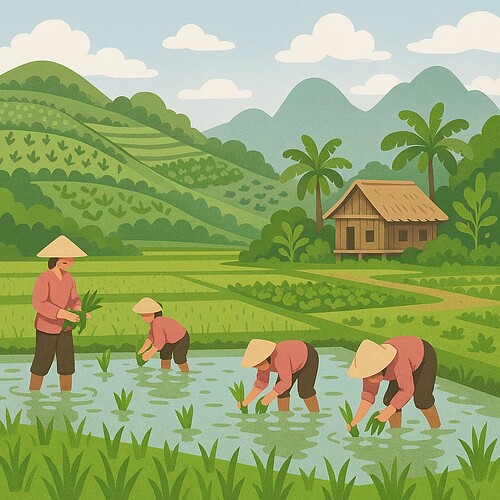The period from April to May is a vital window in Vietnam’s agricultural calendar. As temperatures rise and rainfall patterns begin to shift, this season marks a transitional phase that enables farmers to initiate both short-duration and long-term cropping plans. Strategic planting during this time can ensure not only a bountiful harvest but also resilience against climatic uncertainties. This guide provides a detailed expert recommendation of crops suitable for diverse Vietnamese regions, addressing soil compatibility, crop rotation, and market readiness.
1. Rice (Lúa) – The Foundation of Vietnamese Agriculture
Rice is the dominant staple and cash crop across Vietnam. The country’s diverse geography allows multiple rice-growing seasons, with April to May marking a crucial phase.
Northern Vietnam (e.g., Sapa, Hanoi, Ha Giang)
During this period, farmers begin sowing spring-summer rice (vụ Xuân-Hè). This season is ideal as the temperature rises and irrigation becomes more consistent. Early planting (late April–early May) ensures the crop matures before the heavy rains of late summer. Upland varieties that are flood-tolerant are recommended in mountainous areas.
Southern Vietnam (Mekong Delta, Can Tho, An Giang)
Here, autumn-winter rice (vụ Hè-Thu) begins. April marks the onset of seedling preparation, with transplanting occurring by mid-May. Farmers are advised to use short-duration, high-yield hybrid varieties to combat disease pressure and optimize for quick turnaround, especially in multi-cropping systems.
2. Leafy Greens & Vegetables – Quick-Growing Nutrient-Rich Crops
The warm and humid environment of spring makes April an excellent time for leafy greens and summer vegetables, both for household consumption and market supply.
Recommended Greens
- Water Spinach (Rau muống): Highly preferred for its rapid growth and minimal pest problems. It thrives in standing water or moist soils, making it excellent for lowland areas.
- Mustard Greens (Cải bẹ xanh) and Spinach (Rau dền): These cool-season crops can still be grown in shaded areas. With light irrigation and partial sunlight, they grow tender and pest-free.
- Lettuce (Xà lách): Best grown under nets or partial shade to avoid bolting. Choose heat-resistant varieties for longer harvesting periods.
Summer Vegetables
- Cucumber (Dưa leo) and Pumpkin (Bí đỏ): Should be started in nursery trays in early April and transplanted outdoors by the end of the month. These require well-drained loamy soil and regular compost addition.
- Zucchini (Bí ngòi): Grows quickly in warmer climates; suitable for home gardens and commercial plots alike.
3. Culinary & Medicinal Herbs – Small Investment, High Value
Vietnamese cuisine relies heavily on fresh herbs, and many are ideal for April planting due to favorable humidity and sunlight.
Best Choices
- Vietnamese Coriander (Rau răm): A semi-aquatic plant that enjoys both sun and moisture. Suitable for small pots or ground planting with frequent watering.
- Thai Basil (Húng quế): Prefers high sunlight and thrives in well-aerated soils. A top pick for chefs and herbalists.
- Shiso (Tía tô): Often undervalued, this herb is excellent for culinary and medicinal use. Sow directly in beds with loose soil and good organic content.
These herbs mature quickly (within 4–6 weeks), and with continuous harvesting, they provide returns throughout the season.
4. Root Crops – Profitable and Less Pest-Sensitive
Root vegetables adapt well in Vietnam’s varied terrains. April marks the beginning of warm-season planting for many tubers.
- Ginger (Gừng): Best planted at the start of the rainy season. It requires loose, well-drained soil enriched with compost. In the southern provinces, this crop is grown on raised beds to avoid waterlogging.
- Carrots (Cà rốt), Beets (Củ dền), and Radish (Củ cải): These crops grow quickly, making them suitable for intercropping with longer-duration plants. Ensure sufficient spacing and regular thinning for root expansion.
These crops have a relatively low disease burden compared to leafy vegetables and store well post-harvest.
5. Tropical Fruits – Long-Term Investment, Year-Round Returns
While fruit crops need more space and time, April–May is a strategic window for planting perennials.
- Longan (Nhãn): Needs well-drained, alluvial soil and regular moisture. Start with quality grafted saplings to ensure early fruiting.
- Papaya (Đu đủ): A fast-maturing fruit that begins yielding within 6–8 months. It requires regular fertilization and pest management but is highly profitable.
- Banana (Chuối): Extremely climate-resilient and well-suited for intercropping. Requires minimal care and has steady market demand.
These fruits are best suited for medium-to-large plots or agroforestry systems, providing diversification and risk mitigation over time.
Expert Advice
To maximize success, farmers are advised to conduct soil testing, adopt integrated pest management, and choose region-specific crop varieties. Aligning planting with market cycles and climatic trends ensures better income and sustainability. For further assistance, a custom crop calendar or localized guide can be prepared based on your exact location within Vietnam.
